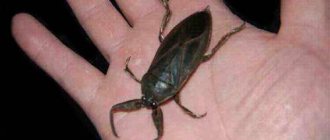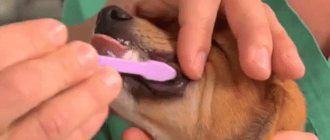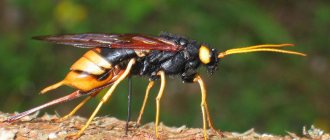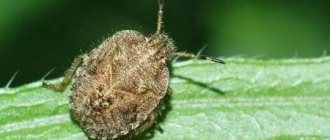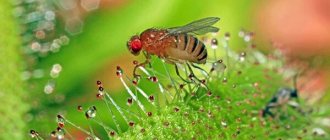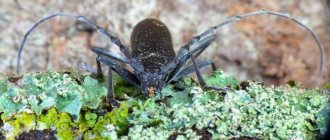The soldier bug (Pyrrhocoris apterus) , also called the red bug or cossack bug, is a terrestrial invertebrate from the family Red bugs and the order Hemiptera.
It reaches 11 mm in length and has a variegated color: black back and elytral plates with a complex red, less often orange, pattern. There are many varieties of patterns; scientists associate the type of pattern on the back with the ecological situation of the area where it was located as a larva.
Kozachek has large, complex, black eyes, a piercing-sucking type of mouthparts, and a proboscis, normally hidden under the body, capable of piercing the chitinous cover of invertebrates. The wingless red bug has a gland in its chest that secretes a strong-smelling secretion and walking-type legs. Their black antennae consist of four segments.
Habitat
This species has a very wide habitat. It can be found throughout the territory, from the Arctic Circle to tropical forests. It inhabits all of temperate Eurasia and northern Africa, and it has also been introduced to North America. In Russia it is present throughout the territory.
What does it eat?
Red bugs and their larvae consume cell sap, using their proboscis to pierce the hard shell of the leaf and gain access to the nutritious sap, without disdaining any plant growing in the garden. It also comes with the seeds and fruits of some trees and shrubs. In rare cases, the wingless red bug can feast on the corpses of small invertebrates and even resort to cannibalism.
Where is it distributed?
The soldier bug is widespread throughout Eurasia, northern Africa and the United States. Countries with a temperate climate are favorable for insect reproduction.
Bedbug habitat:
- under the bark of trees;
- on stumps;
- in piles of dry grass and leaves;
- at the foundations of houses, baths, gazebos and other outbuildings;
- in the fence and its foundation.
kath_gruen
disorder_vortex
entomologist_arina
During hibernation, insects are found under heaps of garbage, in humus, in trees - under the bark or in hollows.
Signs of appearance
The appearance of a red soldier in your garden can be signaled by such phenomena as:
- drying of leaves of umbrella crops;
- the appearance of yellow spots on cabbage leaves;
- falling of buds and flowers;
- curling and drying of root crop tops;
- developmental lag of young seedlings;
- drying of berries.
The easiest way to find signs of damage is in crops such as cabbage (you should pay attention to large yellow spots on the leaves), coriander or dill (they begin to dry out quickly, since these varieties belong to the umbrella family), carrots and beets are inhibited in their development, leaf blades become deformed and wither.
Severely affected crops that cannot be saved must be removed and destroyed. They may contain larvae, which may soon infect surrounding crops.
Thanks to the color of bedbugs, they are easy to spot with the naked eye when they crawl out to bask in the sun. This is their common habit.
Features of the wingless red bug
Territories where the insect prefers to live: Europe, North America and Africa, the northern Palearctic. Bedbugs live in colonies. They do not meet alone. Even if an individual has crawled some distance, there are still brothers nearby.
In such colonies you can see adult bedbugs and larvae at the same time. The number of insects in colonies varies.
Morphology
Bed bugs with a body up to 7-12 mm come from the order Hemiptera. Bright coloring is a distinctive feature of insects. Their backs are decorated with a contrasting red and black pattern.
Gardeners find larvae, which bear little resemblance to adult individuals, under the bark of trees and among cultivated plants in their garden plots. The body of toy soldier larvae is red (some representatives have dark inclusions on the surface).
The bedbug's mouth is unusual. It is a piercing-sucking proboscis. With the help of such a red mouth, it easily penetrates plant tissue, the chitinous shells of dead insects and sucks out juices.
Pests settle in household plots in groups and entire colonies. They attack crop plants en masse. Also, insects go together for the winter, and in the summer they crawl out onto sunny lawns to warm up.
Habitat
Soldier bugs prefer to settle in areas where there are hidden places. They are found on the sunny side. Favorite habitats of such pests:
- the lower part of old fences;
- stumps;
- tree trunk;
- woodpile.
Insects can be seen from afar - beetles with black dots on red backs. Criteria for choosing places for wintering: dryness, the presence of cracks in which heat is well retained. The red soldier bug spends its time here from December to March. Moreover, these insects accumulate in a small area; from the outside it may seem like a bunch of beetles.
In winter, all life processes slow down. This state resembles deep sleep or suspended animation. At the same time, wingless Cossacks do not need to eat or reproduce. They do not move from place to place, but wake up in the spring where they “fell asleep” at the beginning of winter.
By slowing down all processes, energy exchange is reduced, thereby eliminating the need to search for food.
The reserves of nutrients accumulated by individuals in summer and spring are often sufficient to survive the winter.
Although soldiers most often live on stumps, roots and tree trunks, they are often found on grass and flowers
Life cycle
Mating occurs in the spring. During this period, the male and female are attached to each other with the back of the body for quite a long time - from several hours to 7 days. In April-May, a fertilized female lays up to 2030 slightly yellowish eggs in the soil or under dead plants. The duration of egg development depends on external conditions and ranges from 6 to 16 days. The hatched larvae are red with dark spots and resemble a smaller copy of the imago. In about 20 days, the larvae go through 5 stages before becoming sexually mature. During the growing season, 1-2 generations are possible. From December to early March, bedbugs hibernate, choosing dry and warm secluded places for this.
Variety of species
The family has about 65 genera and more than 400 species.
Population and species status
Photo: Fireman Beetle
The soft-bellied family is one of the most numerous. Today it numbers about four thousand beetles, among which fire beetles are considered one of the most common. The “red” beetle is widely represented in various parts of the planet. It is found wherever the climate remains temperate or even cool. It is impossible to determine the exact number of such beetles. However, according to the latest data, the population of this insect species is not at risk of extinction.
The number of firefighters in the natural habitat is unstable, but numerous. Instability usually occurs when people eradicate these insects from large agricultural areas. However, even this does not threaten the total number of firefighters. These beetles do not live long, but they reproduce successfully. From year to year they are rapidly increasing their numbers.
Firefighter beetles are dangerous only if the area is overpopulated. When their population in one place is small, such an insect can be of great benefit. It effectively destroys small garden pests. Firefighters eat caterpillars, aphids, various beetles, and mosquitoes. This is a safe and absolutely free “remedy” for protecting trees, bushes and plants.
The fireman beetle is a prominent representative of a large family of soft beetles. This is a unique creation that looks very much like a fire truck. This insect, provided its population is normal, can be of great benefit to gardeners. It eats almost all the most common pests, while itself does not cause significant harm to plants.
What does it eat?
It may seem that such a bug does not cause harm. Most often it feeds on the remains of insects and seeds that fall to the ground. It is noteworthy that bedbugs prefer to look for food closer to the surface of the soil, because there is more of it here. They rarely climb to the top of trees.
However, the pest’s diet is based not only on dead insects and seeds. Thus, wingless soldier beetles can suck juices from plants: leaves, shoots. They often feed on weeds, but do not disdain plants of various crops in the garden, as well as tree sap and fruits.
The ability to choose different sources of food is due to the rather powerful oral apparatus of the pest.
The proboscis is easily inserted into soft plants and the tougher shell of seeds and carrion.
Reproduction
Unlike representatives of most other types of street bugs, soldier beetles quickly contribute to the appearance of an entire colony of insects. They begin to mate in the spring. The reproduction process looks interesting: the beetles adhere to each other with the rear ends of their bodies, due to which the seed cells enter the female’s body from the male.
Everyone has seen this picture on the street many times: a mating pair of bedbugs with a red and black pattern on their back. Children consider this feature of insects as a way of entertainment, and few adults think about why pests connect with each other. It turns out that mating occurs this way. In appearance, insects resemble a train, because they are constantly moving, and they do it chaotically.
However, this is not the original method. Thus, representatives of other bugs of the order Hemiptera also mate, coupling with the back of the body with a fellow, but this does not happen in plain sight of people, but in hidden places.
This makes the red bug with a black pattern different from other individuals of different species.
The mating process of soldier bugs
Bedbugs reproduce quickly, since the larvae emerge from the shells 1.5 weeks after the female lays eggs. Insect eggs are carefully hidden: inside stems, leaves, cuttings, trunks, shoots. This also contributes to an increase in the number of pests, because most of the offspring are preserved intact.
There are up to 30 eggs in one clutch.
Larvae
After emerging from the protective shells, insects cannot immediately look like adults, since their chitinous covers have not yet formed. Body color is red, and the color is uniform, without black spots. When insects are still small, they can remain motionless for a long time.
Small beetles live
most often on a birch tree. They feed on its juice. Later, when the larvae grow a little, they crawl onto other plants: alfalfa, weeds.
Pests do not attack larger plants. They try to find young shoots, which is due to the incompletely formed oral apparatus. The pest's proboscis is not yet hard. For this reason, the bug will not be able to pierce other plants.
The larvae go through several stages of development, at each of which they shed their chitinous shell. This allows pests to grow. If they do not have time to get rid of the shell, they die. As they mature, the appearance of the larvae changes. At the last stage of development, they become similar to adults.
The larvae are very similar to the adult
Soldier bug bites
Considering that such insects have quite powerful mouthparts, it can be assumed that they, like some predators of the hemipteran order, attack people. However, their proboscis is not too hard. For this reason, a bug will not be able to pierce a person’s skin, even if it sees a threat in the face of a child, whose outer skin is thin and soft.
Even if a person picks up such a pest, nothing but an unpleasant odor will remain on the skin. This beetle will not be able to defend itself, so bite marks do not appear after contact with it.
In addition, soldiers are not parasites; they do not feed on blood, so they have no reason to attack people.
Soldier bug on a man's hand
Reproduction
The breeding period of soldier bugs does not take much time. The mating process occurs in a rather strange way. Two Cossacks cling together with the back of their body and move without disengaging for some time. After this, the female places them inside the plants that she feeds on at this time. One oviposition consists of 20-30 small yellowish eggs and can be located in any above-ground part of the plant.
Larvae
The larvae emerge from the eggs 10-12 days after the eggs are laid; they are small in size and uniformly colored red. They, like adults, use cell sap for nutrition. They often drink the sap of birch, legumes and young shoots, both cultivated varieties and weeds.
The larvae are clearly visible in the spring on the birch bark, where they crawl out to bask in the sun's rays.
Soldier beetle: description
The soldier beetle is a member of the red bug family of terrestrial bugs. Adults grow up to 11 mm in length. This bug is difficult to confuse with other types of insects due to its specific coloring, since on the back, which has a bright red tint, a black pattern appears in the form of an ornament.
The bug's mouth is shaped like a proboscis, which allows the bug to pierce the plant to feed on its juices. The bug feeds on the juice of various weeds and alfalfa juice. The larvae are not able to pierce adult plants with their proboscis, so they feed on the sap of young plants. Insect colonies are concentrated in areas where they can safely hide. They can easily be seen under the bark of drying trees, as well as in places where garbage is piled up, etc.
As mentioned above, the wingless red bug reproduces quite quickly, since at one time the female lays up to 30 oval-shaped eggs, which are in a transparent shell. Within a week and a half, larvae appear from them. From December to February, the soldier beetle hibernates. To do this, they choose special places, then in early spring, when the sun begins to warm up, colonies of soldier beetles are located near the places where they spent the winter.
Harm or benefit of a bug
Despite the fact that until recently the soldier bug was considered harmless to gardens, today science has proven that it is a common pest that brings many problems to farmers and gardeners, eating their gardens and killing young shoots.
After their appearance, the leaves become bent, the shoots do not grow, adult plants become covered with spots and may even die if a large colony has settled in the garden. Due to damage to green cells, photosynthetic capacity decreases, which means the amount of absorbed substances decreases and the yield decreases. Cossacks can do especially a lot of harm to vineyards, where they are most often found.
Kozachek can feed on both stems and fruits of grapes, causing enormous damage to the vineyard. Fortunately, we can say with confidence that this insect is completely harmless to the health of humans and animals, because it does not settle in houses, it can bite a person only in extreme cases, it does not carry any dangerous diseases, bites do not cause allergic reactions, so you should be afraid of the Cossack not worth it.
Features of character and lifestyle
Photo: Fireman beetle in nature
In appearance, the fireman beetle evokes only positive emotions. But its harmless appearance hides a real predator. Firefighter beetles spend almost all day hunting. They stalk their prey in flight, then grab it with their powerful jaws, bite it, and then consume it after exposure to venom. In warm weather, firemen can often be seen on various plants. There they not only bask in the sun, but can also have a snack. Insects gnaw only the fleshy parts of plants.
Firefighter beetles lead an active lifestyle. During the day they fly a lot, love to land and sit for a long time on plants, grass, flowers and fruit trees. These insects are attentive and have a good reaction. If any object approaches, they instantly fly into the sky. If it fails to fly away, the insect can pretend to be dead. To do this, it tucks its paws under itself.
Interesting fact: You should not try to pick up a fireman's beetle. He bites very painfully and releases a special odorous substance at his offender. The insect has sharp teeth and powerful jaws. The bite is quite painful.
Soft beetle larvae spend their day differently. They live on fallen leaves, soil or old wood. They overwinter under the roots of trees, buried deep in the soil or under foliage. The larvae have three pairs of legs, so they move easily and quickly. With the help of powerful jaws, they make their way, making tunnels in the tree. Little firemen feed on centipedes and worms. Outside the shelter, larvae appear very rarely. The only exception is the period of active snow melting. The larvae crawl out to escape the melt water.
What is it often confused with?
The soldier bug is often confused with the firefighter beetle, although they are not very similar to each other.
The fire beetle (Cantharis rustica) is a species of soft-bodied beetle found throughout southern Russia.
This beetle is one and a half to two times longer than the soldier and has a different color (brown elytra and an orange abdomen), they are useful for humans, because they feed on eggs and young insects, thus exterminating many pests. These beetles fly beautifully and also lay eggs in rotten wood. In fact, the soldier is not a beetle at all, since beetles belong to the order Coleoptera, and he belongs to the order Hemiptera.
Why are these insects so often confused? It's very simple, people confuse the soldier bug with the fireman beetle because of the fiery red color of its wing covers.
Life cycle
The lifespan of the wingless bug is 12–14 months. When living in warm regions, two generations of insects appear, in cold regions - one.
The soldier larva does not have such a bright cover
By the end of August, the soldiers' metabolism slows down, i.e. they are preparing for hibernation - suspended animation. After going to sleep, insects survive due to the nutrients accumulated over the summer period and slow metabolism.
The awakening of bedbugs occurs in March - April, as soon as the sun begins to warm the earth and the first vegetation appears. Some young individuals and females cannot withstand the spring cold and die. In May, adult female bedbugs lay eggs. The process of insect formation takes place in several stages: egg – larva – bug. Newly formed females continue breeding in mid-late June.
Fighting methods
So, after you have found one or more signs of the appearance of this insect in your garden, you need to make sure that it is a soldier bug by finding one or more representatives in your area. This is very easy to do thanks to their color. After this, it is worth starting to destroy the pest.
Traditional methods
There is no point in immediately starting heavy artillery using pesticides. It’s better to start with softer traditional methods that are less likely to damage your agrocenosis.
The simplest and most commonly used:
Onion decoction (250 grams per bucket of water, the norm per square meter of soil infested with the pest), wood ash (200 grams per bucket), mustard powder (100 grams per bucket) and laundry soap (1 piece).
This solution should be sprayed on areas with infected plants 1-2 times a week .
Another effective way to combat this pest can be to plant some types of plants on the site, for example black cohosh (commonly called black cohosh).
REFERENCE! This plant effectively repels most types of bedbugs and some other pests; moreover, this species is very beautiful and can serve a decorative function.
Another effective way to exterminate bedbugs is to install a catching belt . A sticky strip wraps around the base of the tree trunk, where the soldier bug is most often found.
Products and chemicals
If folk methods did not help you get rid of the uninvited guest, then it’s time to move on to stronger means. One of the most harmless products for your garden is the drug “Bankol” . It can be purchased at any garden supply store. It will help get rid of adults and larvae, as well as many other types of phyto pests.
ATTENTION! Any chemical is harmful to humans, so you need to strictly follow the instructions, observe the processing time, and after using the drug, do not allow children and pets to the treated areas, do not be there yourself, and use protection during processing (gloves, a raincoat and a respirator). This drug should be used to spot treat infected areas of crops.
You can also use more serious insecticides, such as Karbofos and Aktara.
Natural enemies
The soldier bug has a gland on its back that produces an unpleasant-smelling secretion, a warning color and a bitter taste; therefore, it is not the most attractive delicacy, so a bird can only eat a bug very rarely.
This representative of hemipterans is quite large, so it also has no enemies among insects, except that ants may not disdain a dead bug. However, interspecific cannibalism occurs in the order Hemiptera, especially during the wintering period. Therefore, we can say that the natural enemies of soldier bugs are themselves and humans.
First, a little biology:
The soldier bug, the wingless red bug, the cossack bug, or the red bug (lat. Pyrrhocoris apterus), is a species of ordinary terrestrial bugs of the red bug family, 9-11 mm in size. Found from March to October in grass, bushes and tree trunks. The color is black, the pronotum and elytra are patterned with red. The body is round, slightly flattened. The scutellum is triangular, black in color. The eyes are red. The hind wings are usually absent, but there are exceptions. The antennae consist of five segments. The first segment is very small, barely noticeable. The metathorax contains scent glands.
The insect's mouthparts are of the piercing-sucking type, designed to pierce the shells of seeds, plants and the chitinous shell of small dead insects. In a calm state, the proboscis is located horizontally at the bottom of the head.
Bedbugs reproduce at high speed. The mating process of soldiers is very unusual: the male’s seed cells enter the female’s abdomen when the partners press their backs against each other. Soldiers lay white eggs in the internal tissues of plants (leaves, cuttings, shoots, trunks), on which they currently feed. One oviposition contains from 20 to 30 eggs. Since the type of development in these insects is incomplete metamorphosis (transformation), the soldier bug does not have a pupa. Larvae emerge from eggs after 1.5 weeks. The larva differs from the adult insect in its smaller size and uniformly red color of the body. Hatched larvae go through five stages of development before becoming sexually mature insects, usually requiring 17 to 24 days.
In the northern regions, one generation changes per year, and in the southern regions, two. Nymphs that appear in May become sexually mature in June and begin to mate and reproduce. Insects are active from March to September-October; with the first frost they go into hibernation. The second generation adults leave for the winter. In winter, soldiers hide under the bark of trees, in the cracks of stumps and under piles of leaves.
The homeland of the bug is the countries of central Europe; recently, cases of the appearance of the insect in North America and Southeast Asia have been noted. The soldier bug lives from 6 months to a year.
Prevention
The invasion of these pests can be easily avoided. You just need to prepare the site in advance and follow a few simple rules. Firstly, it is very important to remove weeds in a timely manner and trim the lawn at least once a month; it is advisable to burn all cut and torn grass in order to avoid the spread of the bug, if there are already ovipositors in the grass.
Secondly, it is necessary to uproot old stumps, because this is where the Cossack often settles. You also need to install a fishing belt at the base of the trees in advance. It is necessary to plant legumes separately from other crops, as they often become the starting point of infection, since they are a refuge for Cossacks during the harsh winter months. It is also worth treating the wintering areas of these insects annually with an insecticide (you can use dichlorvos).
Advice from pest control experts
A few tips for eliminating pests:
- To prevent the penetration of red beetles with black dots into agricultural land, seedlings are planned to be planted at a decent distance from weeds, alfalfa and perennial legumes. This is due to the fact that such vegetation is used by soldier bugs for wintering. Whereas after cold weather they need nutrition, which is what the nearby crops provide.
- In addition, weeds, as well as alfalfa, are mowed as low as possible. The maximum height of the grass is 2 cm. Thanks to this, it will be possible to prevent red beetles with black dots from settling and multiplying in the garden.
- When planning to plant in an area where weeds previously grew (quinoa, wormwood, acorn grass, etc.), you must first remove the tops from the area and then burn them. Only after this can ornamental or agricultural crops be planted.
- If it was not possible to avoid the penetration of these pests into the land, you can resort to the help of insecticides. For example, many gardeners recommend using Bankol. This product has no harsh fragrance and is absolutely safe for humans and pets.
Prepare the solution as follows:
- 1 bucket of water;
- 7 gr. Bankola.
Pour into a spray bottle, after which the infected seedlings are sprayed.
- As a preventive measure, you can plant a plant such as black cohosh along the contour of the site. It can be used to repel unwanted pests.
Black cohosh is a guarantee of the absence of parasites on the site
Knowing how the soldier bug parasitizes and how to get rid of it, you can prevent this pest from entering your land. Good luck!
VIDEO: Bedbugs are soldiers

